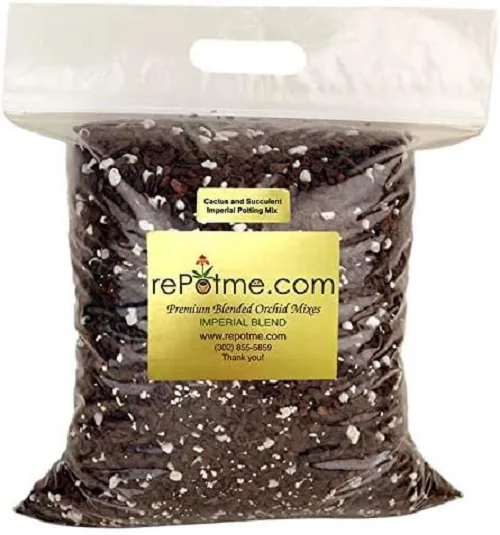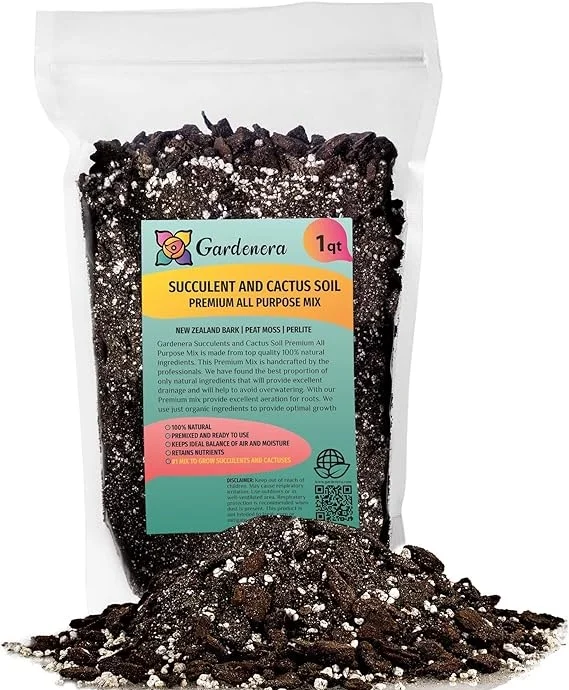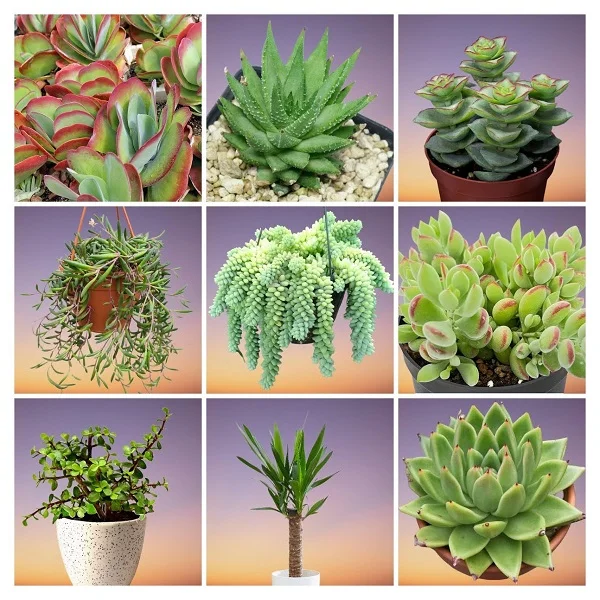Silver Crown Plant (Cotyledon undulata) Care Indoors, Propagation, Problems and Remedies
Some links in this post may be affiliate links
Silver Crown Plant (Cotyledon undulata) grows best in bright light to full sunlight, average warmth, moderate humidity and moderately moist, rich, well-drained soil coupled with monthly feeding in the growing season.
Cotyledon undulata also called Silver Ruffles Plant is a small succulent shrubby plant with unusual gray waxy-edged and bloom-covered leaves that give it a very sculptural shape.
The leaves are shaped like scallop shells. The stems are covered with thick, white, coating. The flowers are orange to yellow.
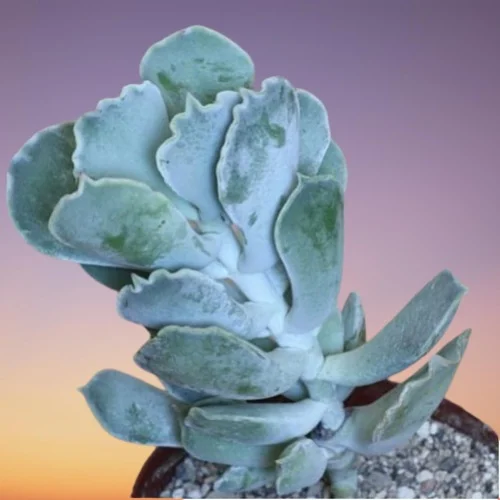
Botanical name: Cotyledon undulata
Family: Crassulaceae
Common names: Silver Crown Plant, Silver Ruffles Plant
Origin
Cotyledon undulata is native to South Africa where they are found on coastal flats and rocky hillsides, or as cremnophytes on cliff faces.
Size
Cotyledon Silver Ruffles is a small succulent shrubby plant which grows to a height of about 1-2 feet.
Is Cotyledon undulata poisonous?
Yes. The leaves in Cotyledon undulata contain cotyledontoxin which is toxic to sheep, goats, horses, cattle, poultry and dogs. If ingested it causes a condition called cotyledonosis. Keep the plant out of the reach of animals.
Related Plants
Cotyledon undulata is related to the following plants which are also great succulent plants for any suitable space.
1. Cotyledon orbiculata (Pig's Ears Plant)
2. Cotyledon campanulata (Bell-flowered Cotyledon)
3. Cotyledon pendens (Cliff Cotyledon)
4. Cotyledon tomentosa (Bear's Paw Succulent)
5. Cotyledon velutina (Velvet Cotyledon)
Where to Buy
Silver Ruffles are spectacular plants for any plant collection. You may obtain these plants online from Etsy (Link to Etsy).
How do you care for Cotyledon undulata indoors?
To care for Cotyledon undulata indoors, give it bright light to full sunlight, average warmth of 16-260C, moderate humidity of 50-55% and moderately moist, fertile, well-drained soil coupled with monthly feeding during the growing season.
Silver Crown Plant care also requires repotting only needed when the plant becomes root-bound. Pruning is necessary to keep the plant neat and to reduce pest and disease infestations. Keep reading for more on the best growing conditions and how to provide them.
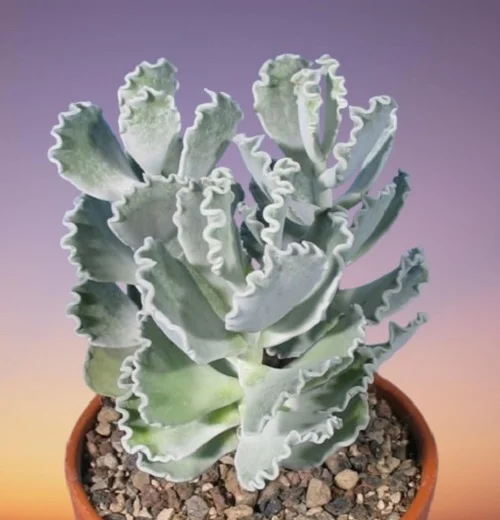
Watering
How often should I water Cotyledon undulata?
Water Cotyledon undulata thoroughly in spring and summer while allowing the top 2-3 inches of soil to dry out between waterings. Maintain the soil moderately moist and avoid overwatering to prevent yellowing and rotting.
Cut down on watering significantly in fall and winter to keep the soil moderately moist. Do not allow the soil to dry out completely to avoid wilting and drooping leaves.
Use room temperature water to water the Silver Ruffles Plant to avoid shocking this tropical plant.
Make sure that the pot has a drainage hole to prevent the soil from getting soggy to avoid root-rot and eventual death of the plant.
Take care not to wet the leaves as it can lead to rotting. Water from the bottom instead.
Light Requirements
How much sun does Cotyledon undulata need?
Cotyledon undulata thrives in bright light to full sunlight. If the light is not enough, the plant may become leggy growing with wide spaces between the leaf nodes.
Therefore, where the natural lighting is not adequate, use full spectrum grow lights to supplement it.
Regularly rotate the pot to ensure that the plant receives light on all sides for even growth and prevent leggy growth.
If you choose to grow your Silver Ruffles Plant outdoors, gradually acclimate it and place it in a shaded place to avoid scorching of the leaves.
Temperature and Humidity
Silver Crown Plant prefers an an average warmth of 16-260C; the sudden change in temperature between day and night is excellent for this succulent plant.
Keep it away from drafts to prevent sudden drops in temperatures which can result in stunted growth and death of the plant.
Cotyledon undulata blossoms in moderate humidity of 50-55%; it has no need for extra humidity. Make sure that there is good air circulation for the plant. Do not mist it to prevent fungal disease infestations which are prevalent in damp, poorly ventillated conditions.
Potting Medium
Silver Crown Plant soil should be rich in organic matter, loose and free-draining to avoid getting soggy soil. The soil should be loose enough to allow water to drain out fast enough. Cactus and succulents mix is ideal for this plant.
Fertilizer
Feed Cotyledon Silver Ruffles with a balanced, liquid fertilizer monthly in spring and summer for lush growth. Stop feeding in the cold season as growth is reduced at this time.
Once in a while, flush out accumulated salts from the soil by running a stream of water through the soil until the water comes out through the drainage hole. Allow it to run for a few minutes and repeat the process several times.
Repotting
Repot Silver Crown Plant only when it becomes pot-bound. Use a shallow rather than a deep pot as it has shallow roots. The pot should be only 1 size larger than the previous one.
Ensure that the pot has a drainage hole to prevent the soil from getting soggy which can lead to root-rot. Use a clay pot because it is porous and therefore allows the soil to dry out faster. Take a look at these terracotta pots available on Amazon.
Pruning
Pruning Silver Crown Plant requires the removal of dead and diseased leaves and dead flowers to maintain the plant neat and discourage pest and disease infestation.
Cotyledon undulata Propagation
Cotyledon undulata propagation is easily done from stem cuttings at the beginning of the growing season (spring to early summer) when the plant is in active growth.
Silver Crown Plant propagation from stem cuttings
- Take a stem cutting of about 2-4 inches long from a healthy plant.
- Ensure that the cutting has 2 or 3 leaf nodes as this is where new growth will come from. Strip off the lower leaves.
- Allow the cuttings to dry (callus) for 1-3 days before planting to prevent rotting.
- Once callussed insert the cutting into moist, cactus and succulents soil as it drains easily.
- Ascertain that the rooting container has a proper drainage to prevent the soil from getting soggy soil to avoid rotting.
- Place the set up in a warm, well-lit place and water sparingly, only when the soil is dry.
- Avoid overwatering as it can lead to rotting by ensuring that the pot has a drainage hole.
- Rooting should occur in 3-4 weeks. Allow the new plant to be well established after which routine care can begin.

Silver Crown Plant Problems & Solutions
Cotyledon undulata problems are brown leaves, leggy growth, leaf drop, leaf spots, diseases and pests among others. Keep reading for more on these problems, their remedies and solutions.
Brown leaves
Why is my Cotyledon undulata leaves turning browning?
Your Cotyledon undulata leaves are turning brown due to inconsistent watering, soggy soil, temperature stress, pests infestations, and fungal diseases.
How to fix it
Inconsistent watering: Do not water on a schedule. Water when the top 2-3 inches dry out. Never allow the soil to dry out completely.
Soggy soil: Use a pot with a drainage hole and well-draining soil.
Temperature stress: Keep the plant away from drafts coming from AC units, drafty windows, heat sources, windy doors and others.
Pest infestations: Regularly inspect the plant for pests and take timely control measures.
Fungal diseases: Avoid wetting the foliage during watering or water from the bottom instead.
Leggy growth
Leggy growth on Silver Crown Plant is caused by too little light overwatering, and excessive feeding.
How to fix it
Too little light: Move the plant to a brighter spot where it will receive bright light with 4-6 hours of direct sunlight or instal a grow light if the natural lighting is not enough.
Overwatering: Water when the top 2-3 inches of soil feel dry. Do water on a schedule.
Excessive feeding: Feed the plant with a balanced, liquid fertilizer monthly in spring and summer but do not feed in fall and winter.
Drooping leaves
Drooping leaves on Cotyledon undulata due to inconsistent watering, soggy soil, temperature stress, and salts buildup.
How to fix it
Immediately water the plant deeply and it should perk up.
Inconsistent watering: Water when the top 2-3 inches of soil dry out but do not allow the soilball to dry out completely.
Soggy soil: Use a pot with a drainage hole and soil drains easily. In addition, always discard the excess water from the saucer.
Temperature stress: Keep the plant away from drafts coming from AC units, heat sources, windy doors among others.
Salts buildup: Do not feed in fall and winter. Regularly leach out accumulated salts by running a stream of water through the soil until it comes out through the drainage hole.
Pests
Common pests on Silver Crown Plant are mealybugs and scale insects.
How to fix it
- Isolate the affected plant to reduce spread to other plants.
- Treat the infested plant with neem oil or insecticidal soap as per the manufacturers' recommendations.
- Regularly check between and underneath the leaves for these pests and carry out timely control measures.
- Keep the plant properly pruned to discourage pest infestations.
Diseases
Cotyledon undulata is prone to the following two diseases:
1. Leaf spot disease which is indicated by brown patches surrounded by a yellow halo.
How to fix it
- Remove and burn the affected parts to reduce the risk of spread to the rest of the plants.
- Spray the affected plant with a systemic fungicide and ensure to cover all the parts with the fungicidal solution.
- Keep the plant on the dry side, do not mist it and ensure good air flow.
- Use a pot with a drainage hole and well-draining soil.
2. Crown and stem-rot disease which is prevalent in overwet conditions. The disease characterized by a rotting plant base followed by yellowing and shrivelled leaves. It is difficult to control as it spreads rapidly and kills the plant.
How to fix it
- To save a plant that is in the early stages of infestation, cut and discard or burn the diseased tissue.
- Maintain free air circulation for your plant to minimize disease infestation.
- Avoid keeping your plant in too cold conditions.
- Avoid keeping the soil soggy by ensuring that the pot has a drainage hole and that the soil is well-drained.
- If the plant is too far gone, discard or burn it. Discard its pot and the soil too to reduce spread to the rest of the plants.
You liked it? Share on social media.
Related Content
Amazon Associates Disclosure
Homeplantsguide.com is a participant in the Amazon Services LLC Associates Program, an affiliate advertising program designed to provide a means for sites to earn advertising fees by advertising and linking to amazon.com.
